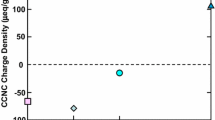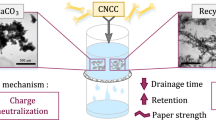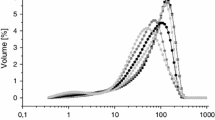Abstract
Cellulose nanocrystals (CNCs), either in intact form or after mechanical shortening, were used as a model nanoparticle for enhancement of dewatering and fine-particle retention during lab-scale papermaking process evaluations. Cryo-crushing, using dry or wet CNCs, was performed to shorten the particles from an initial mean value of 103.1 nm to either 80.4 nm (wet crushed) or 63.4 nm (dry crushed). Papermaking-related tests were performed with the solids from 100 % recycled copy paper, which were prepared as a 0.5 % solids suspension in dilute Na2SO4 solution and then treated successively with 0.05 % of poly-diallyldimethylammonium chloride, 0.05 % of very-high-mass cationic acrylamide copolymer, and then various types and dosages of negatively charged nanoparticles. The performance of the CNCs, relative to papermaking goals, was compared to that of two colloidal silica products that are widely used in industry for this purpose. All of the nanoparticles were observed to promote both dewatering and fine-particle retention. The intact CNCs were more effective than the broken CNCs with respect to fine-particle retention. Effects on flocculation of the fiber suspension were detectable, but not large relative to the sensitivity of the test employed. Results are discussed in the light of concepts of polyelectrolyte bridges and the participation of elongated nanoparticles in completing those bridges in such a way as to form shear-sensitive attachments among solids surfaces in the suspension.









Similar content being viewed by others
References
Abitbol T, Palermo A, Moran-Mirabel JM, Cranston ED (2013) Fluorescent labeling and characterizations of cellulose nanocrystals with varying charge contents. Biomacromolecules 14:3278–3284
Andersson K, Lindgren E (1996) Important properties of colloidal silica in microparticulate systems. Nordic Pulp Paper Res J 11(1):15–21
Andersson K, Sandström A, Ström J, Barla P (1986) The use of cationic starch and colloidal silica to improve the drainage characteristics of kraft pulps. Nordic Pulp Paper Res J 1(2):26–30
Araki J, Wada M, Kuga S, Okano T (1998) Flow properties of microcrystalline cellulose suspension prepared by acid treatment of native cellulose. Colloids Surf A Physicochem Eng Aspects 142(3):75–82
Araki J, Wada M, Kuga S, Okano T (1999) Influence of surface charge on viscosity behavior of cellulose microcrystal suspension. J Wood Sci 45(3):258–261
Asselman T, Garnier G (2001) The flocculation mechanism of microparticulate retention aid systems. J Pulp Paper Sci 27(8):273–278
Beck S, Méthot M, Bouchard J (2015) General procedure for determining cellulose nanocrystal sulfate half-ester content by conductometric titration. Cellulose 22(1):101–116
Breese J (1994) Interactive papermaking chemistry provides machine rebuild options. Pulp Paper 68(4):91–92 (95–97)
Britt KW (1973) Retention of additives during sheet formation. Tappi 56(3):83–86
Britt KW, Unbehend JE (1976) New methods for monitoring retention. Tappi 59(2):67–70
Burgess MS, Phipps JS (2000) Flocculation of PCC induced by polymer/microparticle systems: floc characteristics. Nordic Pulp Paper Res J 15(5):572–578
Burgess MS, Curley JE, Wiseman N, Xiao H (2002) On-line optical determination of floc size. Part 1. Principles and techniques. J Pulp Paper Sci 28(2):63–65
Carlson U (1990) Some aspects of microparticle flocculation. In: The world pulp & paper week: EUCEPA XXIV, Paper Technology, Stockholm, May, pp. 161–171
Carr D (2005) Nanoparticulars on colloidal retention. In: Wet end chemistry, Pira International, Boston, MA, October, Paper 9
Habibi Y (2010) Cellulose nanocrystals: chemistry, self assembly, and applications. Chem Rev 110:3479–3500
Hangen M, Tokarz M (2002) The third generation of nanoparticle retention systems. In: Scientific & technical advances in wet end chemistry, Pira International, Leatherhead, UK, Paper 9
Harms M (1998) Second generation microparticle systems. Wochenbl Papierfabr 126(19):922–924
Honig DS, Farinato RS, Jackson LA (2000) Design and development of the micropolymer system: an ‘organic microparticle’ retention/drainage system. Nordic Pulp Paper Res J 15(5):536–544
Hubbe MA (2000) Reversibility of polymer-induced fiber flocculation by shear. 1. Experimental methods. Nordic Pulp Paper Res J 15(5):545–553
Hubbe MA (2001) Reversibility of polymer-induced fiber flocculation by shear. 2. Multi-component chemical treatments. Nordic Pulp Paper Res J 16(4):369–375
Hubbe MA (2005) Microparticle programs for drainage and retention. In: Rodriguez JM (ed) Micro and Nanoparticles in Papermaking. TAPPI Press, Atlanta, pp 1–36 Chapter 1
Hubbe MA (2007) Flocculation and redispersion of cellulosic fiber suspensions. A review of effects of hydrodynamic shear and polyelectrolytes. BioResources 2(2):296–331
Hubbe MA, Wang F (2002) Where to add retention aid: issues of time and shear. Tappi J 1(1):28–33
Langley JG, Litchfield E (1986) Dewatering aids for paper application. In: Proceedings on TAPPI 1986 Papermakers Conference, pp 89–92
Larson RG (2005) The rheology of dilute solutions of flexible polymers: progress and problems. J Rheol 49(1):1–70
Main S, Simonson P (1999) Retention aids for high-speed paper machines. Tappi J 82(4):78–84
Moffett RH (1994) On-site production of a silica-based microparticulate retention and drainage aid. Tappi J 77(12):133–138
Reiner RS, Rudie AW (2013) Process scale-up of cellulose nanocrystal production to 25 kg per batch at the Forest Products Laboratory. In: Postek MT, Moon RJ, Rudie AW, Bilodeau MA (eds) Production and applications of cellulose nanomaterials. TAPPI Press, Atlanta, pp 21–24
Sampson WW (1997) The interdependence of sheet structure and drainage. Paper Technol Ind 38(8):45–50
Sampson WW, Kropholler HW (1995) Batch-drainage curves for pulp characterization. Part 1. Experimental. Tappi J 78(12):145–151
Sang YZ, McQuaid M, Englezos P (2012) Pre-flocculation of precipitated calcium carbonate filler by cationic starch for highly filled mechanical grade paper. BioResources 7(1):354–373
Sears GW (1956) Determination of specific surface area of colloidal silica by titration with sodium hydroxide. Anal Chem 28(12):1981–1983
Sridhar T, Tirtaatmadja V, Nguyen DA, Gupta RK (1991) Measurement of extensional viscosity of polymer solutions. J NonNewton Fluid Mechan 40(3):271–280
Swerin A, Sjödin U, Ödberg L (1993) Flocculation of cellulosic fibre suspensions by model microparticulate retention aid systems. Nordic Pulp Paper Res J 8(4):389–398
Swerin A, Glad-Nordmark G, Sjödin U (1995) Silica based microparticulate retention aid systems. Paperi Puu 77(4):215–221
Swerin A, Glad-Nordmark G, Ödberg L (1997) Adsorption and flocculation in suspensions by two cationic polymers—Simultaneous and sequential addition. J Pulp Paper Sci 23(8):J389–J393
Wågberg L, Björklund M, Åsell I, Swerin A (1996) On the mechanism of flocculation by microparticle retention aid systems. Tappi J 79(4):157–164
Xu QH, Li WG, Cheng ZL, Yang G, Qin MH (2014) TEMPO/NaBr/NaClO-mediated oxidation of nanocrystalline cellulose and its microparticulate retention system with cationic polyacrylamide. BioResources 9(1):994–1006
Zhang W, Johnson RK, Lin ZY, Cody LC, Audrey ZS, Renneckar S (2013) In situ generated cellulose nanoparticles to enhance the hydrophobicity of paper. Cellulose 20:2935–2945
Acknowledgments
The authors are grateful for support from North Carolina State University for an award of an Undergraduate Research Grant to Caryn Peksa in 2014, for the Buckman Foundation, for support of undergraduate research of Connor Lenze in 2015, and for funding from Northwestern Polytechnical University in Xian, China to support the work of visiting scholar, Dr. Weimin Sun.
Author information
Authors and Affiliations
Corresponding author
Rights and permissions
About this article
Cite this article
Lenze, C.J., Peksa, C.A., Sun, W. et al. Intact and broken cellulose nanocrystals as model nanoparticles to promote dewatering and fine-particle retention during papermaking. Cellulose 23, 3951–3962 (2016). https://doi.org/10.1007/s10570-016-1077-9
Received:
Accepted:
Published:
Issue Date:
DOI: https://doi.org/10.1007/s10570-016-1077-9




